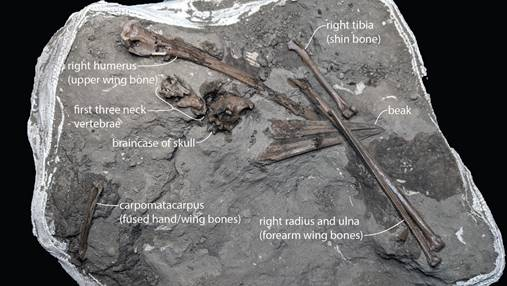SOLOMONS, MD – August 17, 2023 – Most bird bones are very thin, an adaptation to lighten the skeleton for the purpose of flight. Consequently, their delicate bones do not fossilize well. That is why, when even a single isolated fossil bird bone is found along Calvert Cliffs, it’s a big deal. Now just imagine how excited the paleontologists at the Calvert Marine Museum (CMM) became when long-time museum volunteer and gifted fossil finder Mike Ellwood found a partial skeleton (Figures 1 - 3) including a skull of a 12 million-year-old gannet, the most complete bird skeleton ever found along Calvert Cliffs!

What Ellwood first spotted were the ends of a few bones protruding from the sediments at the base of the cliff. Recognizing them as having come from a bird, and with permission from the landowner, he put a cast (what we call a field jacket) around a platter-size block of sediment and brought it to the museum. What Ellwood did not know when he collected the block was that there was a nearly complete skull hiding in the cylindrical block that he had quarried.
CMM Assistant Paleontology Collections Manager Stephen Groff was tasked to prepare the fossil. As he meticulously worked his way down between the wing bones, he discovered that they framed the skull of an extinct species of gannet. Modern gannets are large seabirds that nest on islands or in coastal environments in temperate oceans like the north Atlantic as well as the Chesapeake Bay. From other fragmentary fossilized gannet bones found along the cliffs, we have known that gannets were here during the Miocene epoch when this area was usually under the coastal waters of the prehistoric Atlantic Ocean. However, a bird find like this consisting of a skull and bones from one individual has never been found along the cliffs; it is a once-in-a-lifetime find!
Not only did the shape and size of the skull confirm that it came from an extinct species of gannet, but also the observation that its snout did not have nostrils. Some diving birds don’t have nostrils on the outside of their beak, an obvious and very helpful adaptation to keep water from blowing up their nose when diving into the water at great speed hoping to catch a slippery fish.
The fossil gannet partial skeleton can now be seen in the museum’s fossil preparation lab and will be there until it is removed for scientific study.
Watch the discovery spotlight video produced by Calvert Broadcast recounting the fascinating story. (1) Miocene Gannet Skeleton Discovery along Calvert Cliffs! - YouTube









